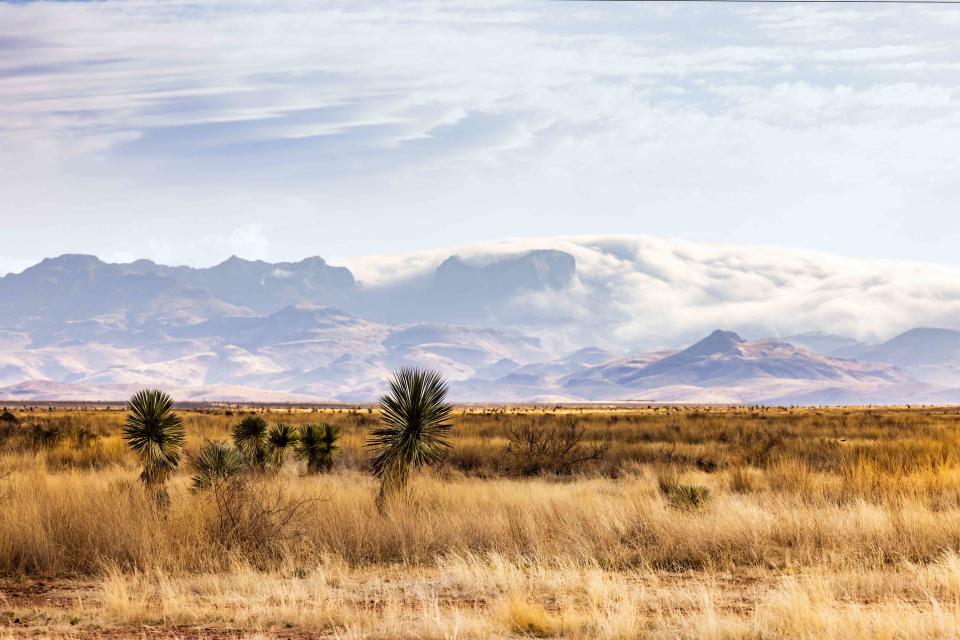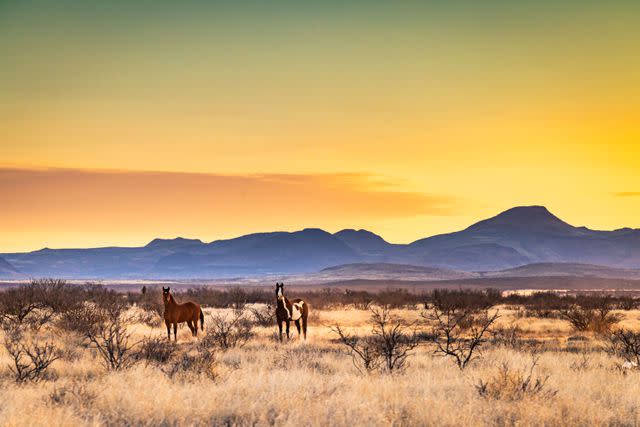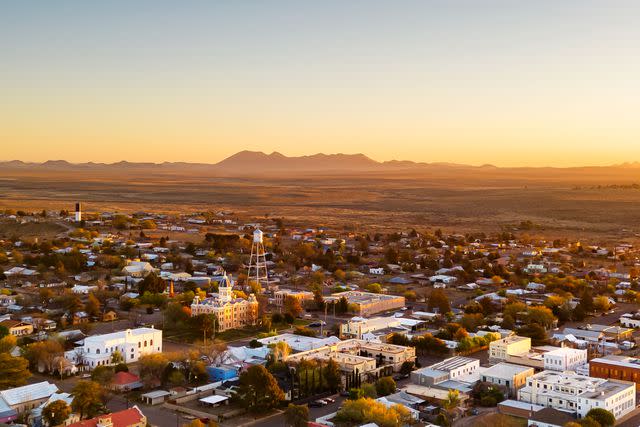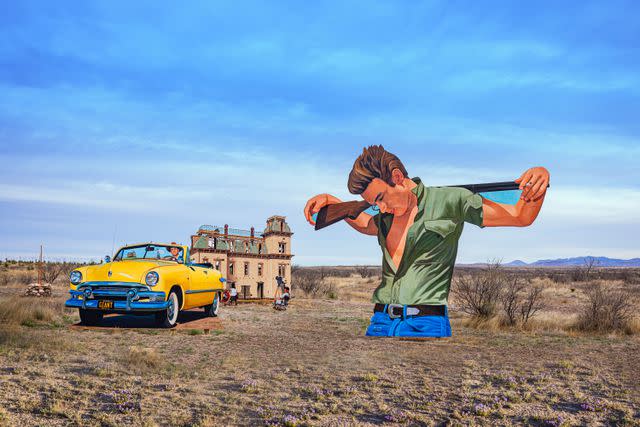Why You'll Never Experience A Place Quite Like Marfa, Texas
In the remote West Texas desert, this funky art town continues to draw attention.

ROBBIE CAPONETTO
Stay on U.S. 90 to see area hot spots like the famed faux Prada store and Marfa Lights viewing area.The sun's going down at the edge of the world, and darkness is coming on quick. We're driving 75 miles an hour on the slim two-lane highway, which somehow feels slow when there's no one else around for miles and miles. The endless fields of dry, scrubby underbrush we've stared at for hours and the prehistoric Davis Mountains rolling in the distance have melted into indiscernible blackness. For all I know, there may be UFOs lurking in the desert around us.

ROBBIE CAPONETTO
Horse and cattle ranches flank U.S. 90 near Marfa, which is surrounded by the Davis, Chisos, and Chinati Mountains.My eyes scan for the bouncing orbs of light we’ve been warned about: the odd, unexplainable, rumored-extraterrestrial “Marfa Lights,” as they’ve been called for decades. Squinting into oblivion, it’s easy to start feeling paranoid. There’s even a remote viewing area where people gather every night in hopes of witnessing the mysterious phenomenon, often leaving with exaggerated “You didn’t catch that?” accounts. We admittedly see none, except for the faraway flashes of what we deduce to be just late-night truck headlights.
Marfa's West Texas History
Out in West Texas, perhaps the most quintessentially Texan place in existence, Marfa does feel like a concealed corner of the world. The nearest commercial airports are both three-hour drives away in El Paso and Midland. In our case, the town is a seven-hour drive from Austin—and from there, you hit the road, losing cell service almost immediately until you roll up to a slow-blinking stoplight that welcomes you to Marfa, coaxing you to choose a direction, none of which spans more than a handful of blocks before nothingness begins again.
Just two generations ago, residents of the Trans-Pecos region, also known as Far West Texas, could never have foreseen all the fuss to come. Marfa was a place where even cattle had a hard time living under the relentless sun, without enough nutrients despite vast desert lands to roam. When artist Donald Judd grew tired of the New York art scene and relocated to Marfa in the early 1970s, he was an eccentric anomaly in the rustic town. He settled into abandoned airplane hangars and started filling the old buildings with his distinctive sculptures, slowly drawing swaths of other creatives from all over the country to Marfa just to see his installations. The town became an unlikely hub attracting curious Texans, artistic bohemians, and incognito celebrities, who continue to flock here throughout the year for its art, film, and music festivals. Still, the population remains under 2,000.

ROBBIE CAPONETTO
The town limits of Marfa span less than 2 square miles.Where To Post Up
We’ve come, fortuitously, on a slow week. A tumbleweed actually skips down the sidewalk upon our initial arrival to El Cosmico, a hotel and 21-acre campground filled with renovated vintage trailers. Our temporary home is a restored Airstream with a mercifully strong air conditioner for the late-afternoon heat waves, but there are also yurts, Bushtec tents, and even a 325-square-foot microhome. You might find musicians congregating with guitars and see an impromptu yoga class flowing on the outdoor stage.
Between wanders into town, we take advantage of wood-fired tubs available for moonlight dips and hammocks swinging lazily across the property. (El Cosmico is slated to begin growing, including by adding the world’s first 3D-printed hotel, this year.) Other well-frequented stays are the modern motor court Thunderbird Hotel, the newly renovated Hotel Saint George, and the historic 1930s-era Hotel Paisano, which served as the de facto headquarters during the filming of the 1956 classic Giant, starring James Dean and Elizabeth Taylor. Lifesize photos from the movie cover the walls.

ROBBIE CAPONETTO
A mural installation by John Cerney honors the 1956 movie Giant, which was filmed partially in Marfa.See the Famed Art Scene
Whatever you’ve heard about Marfa is merely a fraction of its true novelty. Nowhere else are you so keenly aware of out in being cut off from reality and thrust into a microcosm of distant coolness. We are quickly schooled in what locals call “Marfa time,” meaning that things might be open… or perhaps not. A handwritten sign on a restaurant door reads, “Closed on Sundays until we aren’t.” Another on an art-gallery entrance states, “Be back in a few hours, or tomorrow.” Although there’s no really discernible rationale, we chalk it up to the town’s signature quirk and learn not to trust business hours we see online. The Prada Marfa store, however, is always available for visitors, though only from the outside, as it’s an art installation and not a real boutique. We drive around 30 minutes northwest of town to the exhibit, which sits alone against a desert backdrop and succeeds in being intentionally out of place.
As we drive from one art-installation building to the next on our tour of The Chinati Foundation, Judd’s leftover legacy, we notice a family of five German visitors following us in an outdated RV, like a scene out of National Lampoon’s European Vacation. The father whispers constantly in his children’s ears—the youngest kid can’t be much older than 5—gesturing so passionately at the sculptures around us that I wish I could understand him. They’ve driven the beige behemoth-on-wheels days into the Texas desert to visit Judd’s work. Later, I see them many times wandering aimlessly around town and dipping into art galleries such as the world-renowned Ballroom Marfa and the oddities-filled shop called Wrong, their faces glazed in a certain awe of the place. I want to tell them that I feel the same way, though I came from just a few hours away. I am foreign here too.
Wander Around Town
Essentials can be picked up at The Get Go, a miniature gourmet grocery that is miraculously open seven days a week, but it’s best to schedule your Marfa visit to avoid Mondays and Tuesdays, when almost every shop and restaurant is closed. Later in the week, we find unique trinkets and gifts at Garza Marfa, a colorful textile boutique, and Marfa Brand Soap, an ecofriendly bath store. We score a last-minute table at Cochineal, a fine-dining restaurant by chef Alexandra Gates, who prioritizes hyperseasonal ingredients and local meats on an ever-changing prix fixe menu.
“The magic of Marfa is that it has always been accepting of people trying something new or different, and everyone tends to have an open mind,” explains Max Kabat, owner of The Sentinel, a hybrid coffee shop, restaurant, and bar that goes hand in hand with The Big Bend Sentinel, the region’s oldest newspaper, dating back to 1926. Along with his wife, Maisie Crow (a documentary filmmaker and Texas native), he moved to Marfa in 2016 to escape city life and eventually bought the publication from the prior owners of over 30 years. “People here live a little more off the radar, so local news continues to be important,” says Kabat. “But it still takes reimagining to support it.” As a result, The Sentinel caters to both residents looking to keep informed as well as tourists passing through for souvenirs and caffeine.
We encounter similar stories many times—transplants seeking a quieter life away from a bustling metropolis. Marfa seems to have that sort of inexplicable draw that could convince someone to pick up everything and move out to the middle of nowhere. Still, you might come across the rare born-and-raised-here folks, such as Marfa-native couple Mark Scott and Kaki Aufdengarten-Scott. (“Our mothers were even on the same cheerleading squad in the 1970s,” Aufdengarten-Scott tells me.) In 2017, the pair opened Convenience West, which easily stacks up against the best Texas barbecue joints despite its out-of-the-way location and accompanying resource constraints. It’s open only on Fridays and Saturdays until they sell out, which can happen quickly. Among the smoked meats and unexpected sides, such as sweet potato salad and blue cornbread, the surprising standout menu item is the Dip Dip, a roasted-carrot creation served with Fritos Scoops. We savor every bite of the stuff before washing it all down with a glass of chilled wine from Alta Marfa Winery & Vineyard down the street.
Sip a Texas-Native Spirit
The following day, I head over to Marfa Spirit Co., a distillery housed in an 18,000-square-foot former army warehouse built in 1917, which then became a feed mill before the Marfa Spirit Co. team purchased it in 2018. “The building is only on its third life in over a century, which is pretty cool,” says bar manager Laura McShan as she pours me a tasting flight. Sotol is a liquor largely unique to the Chihuahuan Desert region of Mexico and Texas. While some might compare it to agave-based spirits such as tequila or mezcal, it comes from the pervasive sotol plant and has its own earthiness. “Like any good booze, it started as a medicine,” says McShan. “People have been drinking it for hundreds of years.
I watch as on-site distillers Chris King and Ricky Taylor, who moved here from Austin and Houston respectively, load thousands of shreds of fermented sotol plants into the back of a pickup truck. They will then redistribute them on area land as a protective ground cover. Separate from the sotol “juice” (sourced from a multigenerational farm in Janos, Mexico) that serves as the base for their bottled sotol, these plants are harvested nearby and then roasted for five days in an underground pit dug into the earth a few feet away from the distillery. This is how sotol has been traditionally made for centuries. I sneak a sip of this tester batch, and the smokiness envelops my throat instantly. “It tastes like where it comes from,” I’m told, and that’s really the only way to describe it. The strong elixir pairs deliciously with a prosciutto di Parma sandwich picked up from the Italian deli Bordo, which prides itself on wood-fired breads and artisanal cheeses.
Head to Big Bend
After one too many sotol ranch waters and dinner at Margaret’s, a no-reservations bistro where we devour anchovy-topped potato chips and pickled-beet deviled eggs, we awake to a sunny day with a chill in the air. Before heading out to Big Bend National Park and then trekking home, we grab breakfast at Marfa Burrito, watching as owner Ramona Tejada hand rolls each egg-filled tortilla behind the counter. The wood-paneled walls show photos of many smiling strangers—as well as familiar faces such as Anthony Bourdain, Mark Ruffalo, and Matthew McConaughey, who have all frequented this unassuming spot.
As that same slow-blinking stoplight disappears in our rearview mirror, I think about the many people who have been pulled here by some unknown force. And for a split second, even I feel it.
For more Southern Living news, make sure to sign up for our newsletter!
Read the original article on Southern Living.

